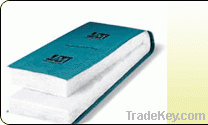Product Description
MR Faced Batts are a lightweight thermal and acoustical fiber glass
insulation made of long, resilient glass fibers bonded with an
acrylic thermosetting binder.
MR Faced Batts are effective when controlling unwanted noise in
internal walls and where vapor control is required; a separate
vapor retarder can be used.
Application
Surfaces
Use Unfaced Batts and Rolls in your home for the appropriate
application surfaces listed in the table below. Not all products
are used in all applications. Enter your zip code for the
recommended R-value for your geographical area.
How to Install Roll
Insulation
Installation Tips
1. Open the packages by cutting lengthwise through
the side panel. Be careful to avoid cutting the product or facing.
The insulation will quickly expand to its full volume when the bag
is opened.
2. Rolls must be measured and cut to fit into wall
cavities. Cut insulation about an inch wider than the space using a
sharp utility knife against a safe backstop, such as an unfinished
floor or other smooth, flat surface. Always cut on the unfaced side
of the batt.
3. Cut the insulation to fit properly. Don't
double it over or compress it. Compression changes the R-value of
the insulation.
4. Gently push insulation into the cavity so that
it sits all the way, especially at the corner and edges. Then,
fluff it to its full expansion by pulling it forward to fill the
depth of the cavity. The fit should be snug.
5. With faced insulation make sure the vapor
retarder is facing the conditioned interior space, unless building
codes specify otherwise.
6. Allow friction to hold the insulation in place.
Or you can staple the flanges of faced insulation to the insides or
face of the joists. (Stapling on the inside is preferred by many
drywallers because it leaves the edges of the framing members
easier to locate. However, your local building codes may require
you to overlap the flanges and staple them to the edges of the
framing members.)
7. Take care not to stretch the facing too tight
as you staple, which can over compress the insulation, and avoid
gaps and puckers.
8. Secure floor insulation with wire fasteners,
sometimes called "lightning rods." Press the fasteners so they bow
up gently against the subflooring without compressing it. Space the
fasteners at least six inches from each end of the batt and *2" -
*4" apart.
9. When installing rolls in an unfinished attic or
other large open area, simply unroll the insulation in place.
*0. Wherever there are adjacent rolls, make sure
they fit snugly together.
| Country: |
USA |
| Model No: |
-
|
| FOB Price: |
(Negotiable)
Get Latest Price
|
| Place of Origin: |
- |
| Price for Minimum Order: |
- |
| Minimum Order Quantity: |
- |
| Packaging Detail: |
- |
| Delivery Time: |
- |
| Supplying Ability: |
- |
| Payment Type: |
D/P, T/T |
| Product Group : |
- |

